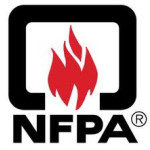- Industry: Fire safety
- Number of terms: 98780
- Number of blossaries: 0
- Company Profile:
Established in 1896, NFPA's mission is to reduce the worldwide burden of fire and other hazards on the quality of life by providing and advocating consensus codes and standards, research, training, and education.
(1) The tendency or capacity to remain afloat in a liquid. (2) The upward force of a fluid upon a floating object.
Industry:Fire safety
(1) The mooring of a boat alongside a bulkhead, pier, or between piles. (2) A sleeping space.
Industry:Fire safety
(1) The section of the upper deck of a ship located at the bow, forward of the foremast. (2) A superstructure at the bow of a ship where maintenance shops, rope lockers, and paint lockers are located.
Industry:Fire safety
(1) One of the upright, vertical partitions dividing a ship into compartments and serving to retard the spread of leakage or fire. (2) A fixed pier or wall back-filled to be continuous with the land.
Industry:Fire safety
(1) The ensemble, element, component, or composite that is conditioned for testing. (2) Ensembles, elements, items, or components that are randomly selected from the manufacturer’s production line, from the manufacturer’s inventory, or from the open market.
Industry:Fire safety
(1) Sensing the existence of a fire, especially by a detector from one or more products of the fire, such as smoke, heat, infrared radiation, and the like. (2) The act or process of discovering and locating a fire.
Industry:Fire safety
(1) Equipment, such as anchors, chains, or lines, for holding fast a vessel. (2) The act of securing a vessel. (3) A location at which a vessel can be moored. (4) Any location where a boat is wet-stored or berthed.
Industry:Fire safety
(1) Not readily capable of burning with a flame. (2) Not liable to ignite and burn when exposed to flame. Its antonym is flammable.
Industry:Fire safety
(1) In general, the capacity of a structure or member to resist the effects of loads, as determined by computations using specified material strengths and dimensions and formulas derived from accepted principles of structural mechanics or by field tests or laboratory tests of scaled models, allowing for modeling effects and differences between laboratory and field conditions. (2) For the purposes of earthquake loading, strength of a member or cross section calculated in accordance with the requirements and assumptions of the strength design methods of ASCE/SEI 7 (or the referenced standards) before application of any strength reduction factors.
Industry:Fire safety
